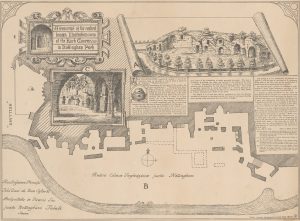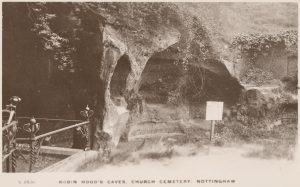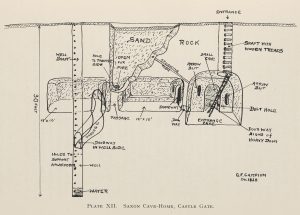January 16, 2025, by Chloe
Temples, tombs and troglodytes: the mythical origins of Nottingham’s caves
Upon encountering Nottingham’s caves, it was clear to many early antiquarians that these mysterious and little-understood structures must have deep roots, stretching back millennia into the distant past.
An early proponent of this theory was the Elizabethan travel writer William Camden (1551-1623), who claimed in his landmark survey, ‘Britannia’, that the caves had been dug as homes for Saxon inhabitants of the town. And he wasn’t alone: subsequent scholars would go on to suggest even earlier origins. A century and a half later, when making the first detailed drawings of the caves at Lenton Hermitage, the prominent antiquarian William Stukeley designated them as a ‘troglodyte colony’ built by ancient Britons, for use not only as housing, but also as a temple for druidical rituals. Perhaps stepping foot in these subterranean spaces so inspired Stukeley that he felt they must have had a mystical purpose. While the site has since been proven to be a medieval structure, he was right in a sense: it was a chapel, home to hermits associated with Lenton Priory.

Print of a drawing by T.C. Hine made from an earlier drawing by William Stukeley, showing the caves in Nottingham Park; 1892. University of Nottingham NPE X 3/1
Druids would prove to be a recurring theme, popping up again in the aptly titled pamphlet Shadows Departed by Reverend George Oliver (1782-1867). Oliver argued that the caves in Church Cemetery (colloquially known as ‘Robin Hood’s Hole’) were in fact the remains of a druidic temple, going to great lengths to describe the design features he imagined had existed, as well as the rituals he envisioned being practiced there.

Photograph of Robin Hood’s caves; undated [early 20th century]. University of Nottingham MS 607/6/18
But temples and housing were not the only imagined uses of the caves. Thomas Chambers Hine (1813-1899) may have been best known for making his mark on Nottingham’s architectural landscape, including the remodelling of the Castle in the 1870s, but he also made his own contribution to the lore surrounding the caves’ mysterious origins. In his history of the Castle, published in 1876, he argued that the nearby caves were in fact a Roman burial site, complete with niches where jars containing the ashes of the dead would have been stored. In the century and a half since, no evidence for a Roman settlement in Nottingham has ever been discovered, and the niches have been reinterpreted as a dovecote, designed for keeping pigeons or doves.

Photograph of alleged ‘Roman Sepulchrum’ from Nottingham, its castle by TC Hine, p.4; 1876. University of Nottingham, EMSC Not 3.D64 CAS.
Strangely, even the birth of scientific archaeology did not lay these rumours to rest – at least, not at first. George Campion, a prominent Nottingham archaeologist of the interwar years, may have led the Thoroton Excavation Section (later the Nottingham Archaeological Society) in the first systematic investigation of the caves, but even he was susceptible to the influence of his predecessors. Despite having examined the caves closely, he maintained that many of them were Anglo-Saxon in origin, and that they had been underground houses, part of an extensive settlement designed to protect its inhabitants from attack. This belief informed his interpretation of the sites he worked on, designating many caves as ‘cave-homes’ and labelling what are now understood to be wells as chimneys or entrance-shafts.

Diagram of ‘Saxon Cave-Home, Castle Gate’ by George Campion, from Third Annual Report of Thoroton Society of Nottinghamshire, Excavation Section, p.29; 1938. University of Nottingham EMC Periodicals: Not/Thor Soc.
If you’d like to find out more about the many outlandish origin myths about Nottingham’s caves, why not check out our current exhibition, ‘Tales from the Caves’, which is running in the Weston Gallery at Lakeside Arts, Nottingham until 9 March 2025? Learn more on our website!
No comments yet, fill out a comment to be the first

Leave a Reply